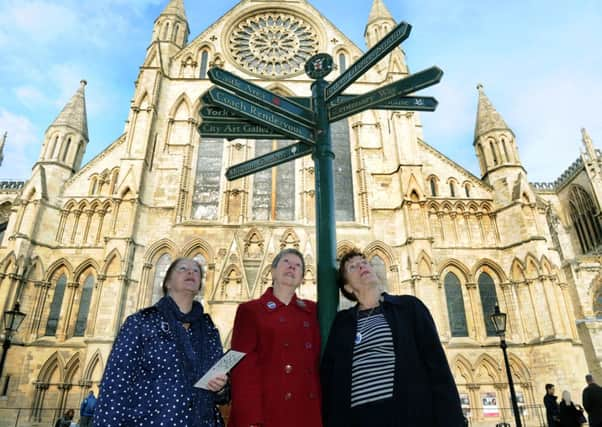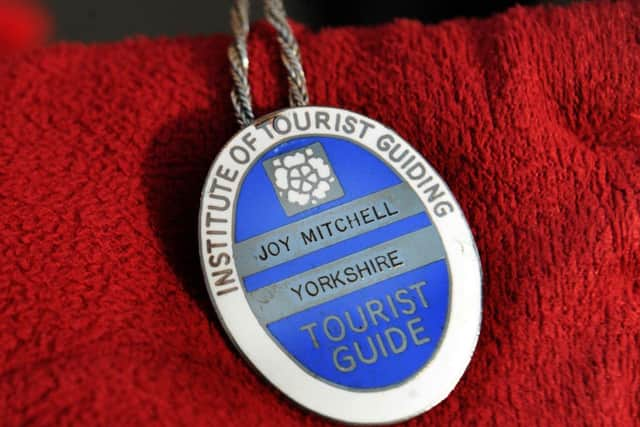Blue Badge brigade making memories for sightseers on Yorkshire grand tour


A GREAT guide is someone whose enthusiasm for a place is so great that they bring its history, geography, industry and culture to life. They leave you, the tourist passing through, with indelible memories.
A bad or indifferent guide, on the other hand, can leave you with nothing but sore feet and a bad taste in your mouth.
Advertisement
Hide AdAdvertisement
Hide AdOne gifted Blue Badge Guide, plying her trade on a hop-on, hop-off open-top bus tour of Edinburgh, held us so rapt by her stories of volcanoes, pillaging, clan warfare and grave-robbing that we clean forgot to get off.


Another wonderful guide, working at the ancient site of Ephesus in Turkey, had such a gift for bringing the long dead to life that when we went back decades later we remembered every step of the route taken by Roman sailors from the port to the city’s nearest brothel.
A guide has to know the history, geography, geology, archaeology and sociology of their patch, as well as understanding its cultural and industrial heritage, agriculture and more.
“Germans tend to ask why we have so many chimneys,” says Louise Keegan, a former social worker from York, who trained as a Blue Badge Guide (BBG) for Yorkshire in the mid-1990s and also holds badges for most of the rest of the North of England.
Advertisement
Hide AdAdvertisement
Hide AdOn top of her Blue Badge training, she took the four-and a-half-day course needed to explain the vast story of York Minster. She has guided groups as large as 35 people on visits to Leeds, Bradford and Wakefield, the Dales, North York Moors and villages and towns of Yorkshire’s East Coast.
“Some people are obsessed with the height and width of buildings, and I was once asked the total weight of the stone used to build York Minster,” says Louise.
Anyone with interest, enthusiasm and the ability to absorb facts can set themselves up as a tourist guide – but the Blue Badge qualification is seen as the Gold Standard, a stamp of quality recognised worldwide.
These self-employed guides have a head full of knowledge, an outgoing personality that helps them to communicate interestingly and entertainingly, stamina, and the ability to tailor a tour to changing circumstances or special interests.
Advertisement
Hide AdAdvertisement
Hide AdLouise loves being her own boss and the fact that no two groups are the same. The work is seasonal: business picks up in March, is particularly busy in May and June and tails off between September and November.
She says the job keeps her learning – “I went to a talk about Hull last night. You have to be prepared to continue studying.” She upgraded her German to a degree so she could guide in a second language (although this is not essential).
Fees should be increasing for 2014, but this year a guide could earn around £140 per half day and £210 for a full day, although the job doesn’t provide a regular, predictable income, unless a guide work for a tour operator running scheduled tours. Those who can guide in a second language earn more.
Guides are freelance and responsible for paying their own tax and National Insurance, as well as public liability insurance. It takes time to build up a good client list, but Louise gets enough bookings at busy times to work most days.
Advertisement
Hide AdAdvertisement
Hide AdA standard tour of York takes two hours, plus an hour if the Minster is included. We set off from the Minster’s West Door on a miniature circuit that takes in Bootham Bar, part of the city walls, King’s Manor and the Museum Gardens, looping back to the Minster via The Shambles.
“You can’t just put together a one-size-fits-all spiel,” she says. “A group of teenagers can’t take much of the Romans and just want to know where McDonald’s is. I try to keep them entertained by highlighting some of the ghost stories about York.”
I’m treated to a clear view of her wide knowledge and skill as she plies me with information and stories ranging from the building of the Roman fort in AD71 to 19th century William Etty’s campaign to save the city walls from destruction, nodding to St Mary’s Abbey, the handsome statue of war god Mars (in the museum) and York Observatory.
In between history and anecdote, Louise tells me the tourist mix now includes fewer Americans than in yesteryear “...frightened off by foot and mouth and 9/11” . The major groups are Europeans but with growing numbers of Russians and visitors from Asia.
Advertisement
Hide AdAdvertisement
Hide AdIn The Shambles she paints a vivid picture of a street that, centuries ago had the blood from animal slaughter running down the middle, thanks to the 31 butchers’ shops that traded here.
We break off the tour to meet up with Louise’s colleagues Jenny Denton, also from York, and Joy Mitchell, from Leeds. Jenny’s had decades of experience, having first worked as a volunteer for the National Trust and as a City of York volunteer guide.
“History was always my favourite subject at school. A busier week can include walking tours of York, coach tours of the Dales and North York Moors, and popular spots like Rievaulx Abbey. Obviously, with places you go to less you have to brush up a few facts the night before.”
She giggles about a recent experience with a group of Russian men. “We did the Historic York tour, and at the end I asked where they were going next, in case they needed help in getting there. They asked where the nearest sex shop was – and being a good guide I directed them.”
Advertisement
Hide AdAdvertisement
Hide AdJoy is about to head off for a day and a half with an American couple who are replicating the tour of the UK they did for their honeymoon 25 years ago. “Sometimes a small number can be more difficult than managing a big group, but usually you get along fine.”
She studied modern languages at university, then lived in Madrid, Milan and Paris before becoming a teacher. She did the two-year BBG training 18 years ago and works in any of four languages.
The three friends obviously love the job. They’re concerned, though, that as Blue Badge Guides retire the number in Yorkshire has dwindled to just 12.
Yet, as Louise says, guides are in great demand – which is expected to increase when Yorkshire is the focus of the Tour de France’s Grand Depart next year.
Advertisement
Hide AdAdvertisement
Hide Ad“The training of Blue Badge Guides is not funded by any organisation, so there hasn’t been a training course since 1996. Yorkshire Forward were considering putting money in, but then the regional development agencies were disbanded.”
Louise is one of the organisers of a fully accredited training course for BBGs and Green Badge Guides (for the City of York only) which will start in early December.
The course costs the trainee just under £4,000,but includes many visits, coach tours, venue hire and expert tuition. Training is mostly on Wednesdays and a series of intensive weekends, and embraces most aspects of the region, its principal cities and tourist spots.
All aspects of guiding work are covered, as well as the business side of the job and how to market your skills.
Advertisement
Hide AdAdvertisement
Hide Ad“It may seem like a lot of money, but it’s less than a year at university would cost,” says Louise. “It’s a highly coveted qualification and an investment in a wonderful career.”
The next training course for Green Badge tourist guides for York and Blue Badge guides for Yorkshire will start in early December. For information and an application form email [email protected]. Applications close on Friday but those posted on that date will be accepted if date of postage is notified.
What makes a good guide?
A guide needs a good, clear speaking voice and smart appearance. They must be knowledgeable about Yorkshire and able to convey that knowledge in an engaging, entertaining manner.
They need to be a ‘people’ person, they also require patience and stamina to cope with long days. They should be well-organised, punctual, and familiar with research techniques on the internet.
Advertisement
Hide AdAdvertisement
Hide AdThe training programme can teach people many of the facts and figures needed to do the job and help with the development of ‘tourcraft,’ but each guide brings their own personality to the job.
Training includes the business side of tourist guide work and marketing.